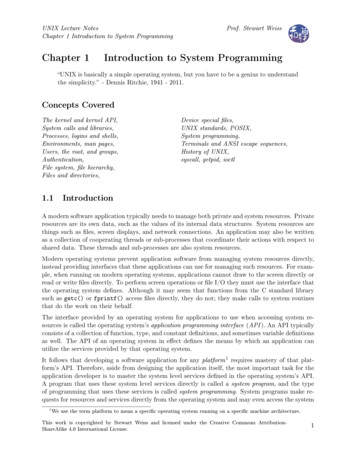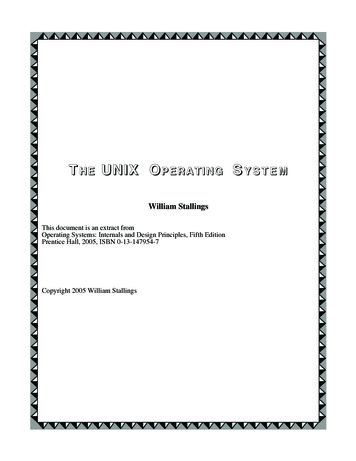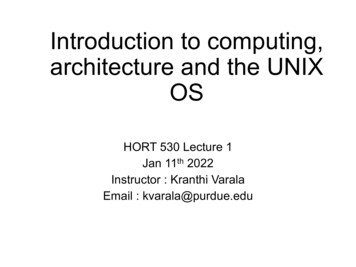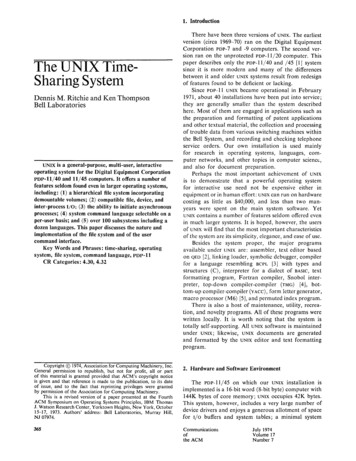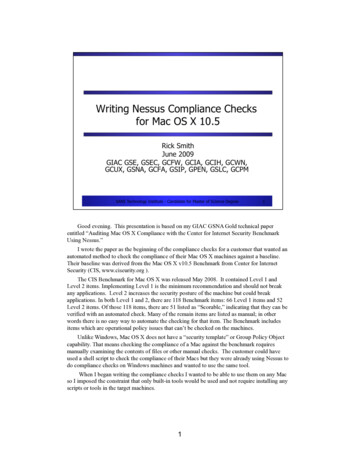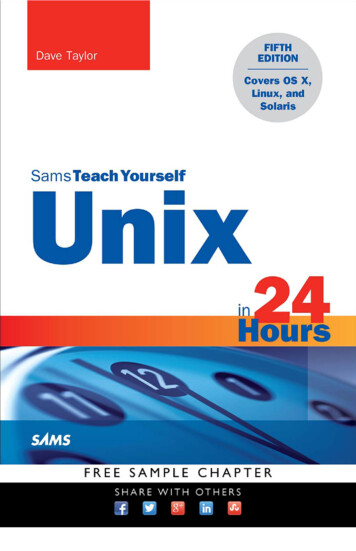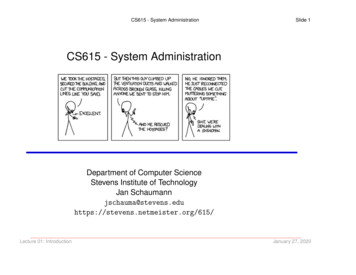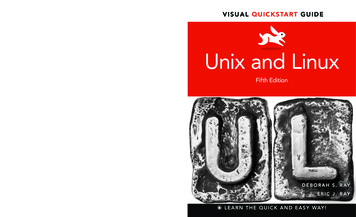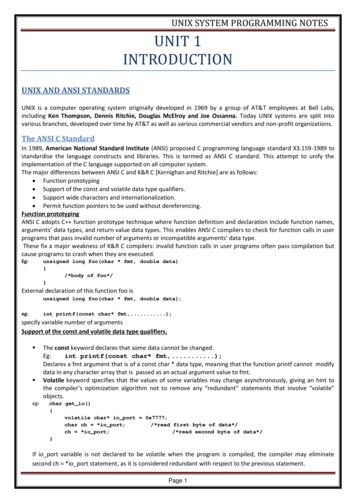
Transcription
UNIX SYSTEM PROGRAMMING NOTESUNIT 1INTRODUCTIONUNIX AND ANSI STANDARDSUNIX is a computer operating system originally developed in 1969 by a group of AT&T employees at Bell Labs,including Ken Thompson, Dennis Ritchie, Douglas McElroy and Joe Ossanna. Today UNIX systems are split intovarious branches, developed over time by AT&T as well as various commercial vendors and non-profit organizations.The ANSI C StandardIn 1989, American National Standard Institute (ANSI) proposed C programming language standard X3.159-1989 tostandardise the language constructs and libraries. This is termed as ANSI C standard. This attempt to unify theimplementation of the C language supported on all computer system.The major differences between ANSI C and K&R C [Kernighan and Ritchie] are as follows: Function prototyping Support of the const and volatile data type qualifiers. Support wide characters and internationalization. Permit function pointers to be used without dereferencing.Function prototypingANSI C adopts C function prototype technique where function definition and declaration include function names,arguments’ data types, and return value data types. This enables ANSI C compilers to check for function calls in userprograms that pass invalid number of arguments or incompatible arguments’ data type.These fix a major weakness of K&R C compilers: invalid function calls in user programs often pass compilation butcause programs to crash when they are executed.Eg:unsigned long foo(char * fmt, double data){/*body of foo*/}External declaration of this function foo isunsigned long foo(char * fmt, double data);eg:int printf(const char* fmt,.);specify variable number of argumentsSupport of the const and volatile data type qualifiers. eg:The const keyword declares that some data cannot be changed.Eg:int printf(const char* fmt,.);Declares a fmt argument that is of a const char * data type, meaning that the function printf cannot modifydata in any character array that is passed as an actual argument value to fmt.Volatile keyword specifies that the values of some variables may change asynchronously, giving an hint tothe compiler’s optimization algorithm not to remove any “redundant” statements that involve “volatile”objects.char get io(){volatile char* io port 0x7777;char ch *io port;/*read first byte of data*/ch *io port;/*read second byte of data*/}If io port variable is not declared to be volatile when the program is compiled, the compiler may eliminatesecond ch *io port statement, as it is considered redundant with respect to the previous statement.Page 1
UNIX SYSTEM PROGRAMMING NOTES The const and volatile data type qualifiers are also supported in C .Support wide characters and internationalisation ANSI C supports internationalisation by allowing C-program to use wide characters. Wide characters usemore than one byte of storage per character.ANSI C defines the setlocale function, which allows users to specify the format of date, monetary and realnumber representations.For eg: most countries display the date in dd/mm/yyyy format whereas US displays it in mm/dd/yyyy format.Function prototype of setlocale function is:#include locale.h char setlocale (int category, const char* locale); The setlocale function prototype and possible values of the category argument are declared in the locale.h header. The category values specify what format class(es) is to be changed.Some of the possible values of the category argument are:category valueeffect on standard C functions/macrosLC CTYPELC TIMELC NUMERICLC MONETARYLC ALL Affects behavior of the ctype.h macrosAffects date and time format.Affects number representation formatAffects monetary values formatcombines the affect of all abovePermit function pointers without dereferencingANSI C specifies that a function pointer may be used like a function name. No referencing is needed when calling afunction whose address is contained in the pointer.For Example, the following statement given below defines a function pointer funptr, which contains the address ofthe function foo.extern void foo(double xyz,const int *ptr);void (*funptr)(double,const int *) foo;The function foo may be invoked by either directly calling foo or via the funptr.foo(12.78,”Hello world”);funptr(12.78,”Hello world”);K&R C requires funptr be dereferenced to call foo.(* funptr) (13.48,”Hello usp”);ANSI C also defines a set of C processor(cpp) symbols, which may be used in user programs. These symbols areassigned actual values at compilation time.cpp SYMBOLUSESTDCFeature test macro. Value is 1 if a compiler is ANSI C, 0 otherwiseLINEEvaluated to the physical line number of a source file.FILEValue is the file name of a module that contains this symbol.DATEValue is the date that a module containing this symbol is compiled.TIMEvalue is the time that a module containing this symbol is compiled.The following test ansi c.c program illustrates the use of these symbols:#include stdio.h int main(){#if STDC 0printf(“cc is not ANSI C compliant”);#elseprintf(“%s compiled at %s:%s.This statement is at line %d\n”,FILE , DATE , TIME , LINE );#endifReturn 0;}Page 2
UNIX SYSTEM PROGRAMMING NOTES Finally, ANSI C defines a set of standard library function & associated headers. These headers are the subsetof the C libraries available on most system that implement K&R C.The ANSI/ISO C StandardThese compilers support C classes, derived classes, virtual functions, operator overloading. Furthermore, theyshould also support template classes, template functions, exception handling and the iostream library classes.Differences between ANSI C and C ANSI CC Uses K&R C default function declaration for anyfunctions that are referred before theirdeclaration in the program.int foo();ANSI C treats this as old C function declaration &interprets it as declared in following manner.int foo(.); meaning that foo may be calledwith any number of arguments.Does not employ type safe linkage techniqueand does not catch user errors.Requires that all functions must be declared /defined before they can be referenced.int foo();C treats this as int foo(void);Meaning that foo may notarguments.accept anyEncrypts external function names for type safelinkage. Thus reports any user errors.The POSIX standards POSIX or “Portable Operating System Interface” is the name of a family of related standards specified by theIEEE to define the application-programming interface (API), along with shell and utilities interface for thesoftware compatible with variants of the UNIX operating system.Because many versions of UNIX exist today and each of them provides its own set of API functions, it isdifficult for system developers to create applications that can be easily ported to different versions of UNIX.Some of the subgroups of POSIX are POSIX.1, POSIX.1b & POSIX.1c are concerned with the development ofset of standards for system developers.POSIX.1 This committee proposes a standard for a base operating system API; this standard specifies APIs forthe manipulating of files and processes. It is formally known as IEEE standard 1003.1-1990 and it was also adopted by the ISO as theinternational standard ISO/IEC 9945:1:1990.POSIX.1b This committee proposes a set of standard APIs for a real time OS interface; these include IPC (interprocess communication). This standard is formally known as IEEE standard 1003.4-1993.POSIX.1c This standard specifies multi-threaded programming interface. This is the newest POSIX standard. These standards are proposed for a generic OS that is not necessarily be UNIX system. E.g.: VMS from Digital Equipment Corporation, OS/2 from IBM, & Windows NT from MicrosoftCorporation are POSIX-compliant, yet they are not UNIX systems. To ensure a user program conforms to POSIX.1 standard, the user should either define themanifested constant POSIX SOURCE at the beginning of each source module of the program(before inclusion of any header) as;#define POSIX SOURCEOr specify the -D POSIX SOURCE option to a C compiler (CC) in a compilation;%CC -D POSIX SOURCE *.C POSIX.1b defines different manifested constant to check conformance of user program to thatstandard. The new macro is POSIX C SOURCE and its value indicates POSIX version to which a userprogram conforms. Its value can be:Page 3
UNIX SYSTEM PROGRAMMING NOTESPOSIX C SOURCE VALUESMEANING198808LFirst version of POSIX.1 compliance199009LSecond version of POSIX.1 compliance199309LPOSIX.1 and POSIX.1b compliance POSIX C SOURCE may be used in place of POSIX SOURCE. However, some systems that supportPOSIX.1 only may not accept the POSIX C SOURCE definition. There is also a POSIX VERSION constant defined in unistd.h header. It contains the POSIX versionto which the system conforms.Program to check and display POSIX VERSION constant of the system on which it is run#define POSIX SOURCE199309L#define POSIX C SOURCE#include iostream.h #include unistd.h int main(){#ifdef POSIX VERSIONcout “System conforms to POSIX” “ POSIX VERSION endl;#elsecout “ POSIX VERSION undefined\n”;#endifreturn 0;}The POSIX EnvironmentAlthough POSIX was developed on UNIX, a POSIX complaint system is not necessarily a UNIX system. A few UNIXconventions have different meanings according to the POSIX standards. Most C and C header files are storedunder the /usr/include directory in any UNIX system and each of them is referenced by#include header-file-name This method is adopted in POSIX. There need not be a physical file of that name existing on a POSIX conformingsystem.The POSIX Feature Test MacrosPOSIX.1 defines a set of feature test macro’s which if defined on a system, means that the system has implementedthe corresponding features. All these test macros are defined in unistd.h header.Feature test macroPOSIX JOB CONTROLPOSIX SAVED IDSPOSIX CHOWN RESTRICTEDPOSIX NO TRUNCPOSIX VDISABLEEffects if definedThe system supports the BSD style job control.Each process running on the system keeps the saved set UID and the setGID, so that they can change its effective user-ID and group-ID to thosevalues via seteuid and setegid API's.If the defined value is -1, users may change ownership of files owned bythem, otherwise only users with special privilege may change ownershipof any file on the system.If the defined value is -1, any long pathname passed to an API is silentlytruncated to NAME MAX bytes, otherwise error is generated.If defined value is -1, there is no disabling character for specialcharacters for all terminal device files. Otherwise the value is thedisabling character value.Page 4
UNIX SYSTEM PROGRAMMING NOTESProgram to print POSIX defined configuration options supported on any given system./* show test macros.C */#define POSIX SOURCE#define POSIX C SOURCE199309L#include iostream.h #include unistd.h int main(){#ifdef POSIX JOB CONTROLcout “system supports job control”;#elsecout “ system does not support job control\n”;#endif#ifdef POSIX SAVED IDScout “ system supports saved set-UID and set-GID”;#elsecout “ system does not support set-uid and gid\n”;#endif#ifdef POSIX CHOWN RESTRICTEDcout “chown restricted option is :” POSIX CHOWN RESTRICTED endl;#elsecout ”system does not support” ” chown restricted option\n”;#endif#ifdef POSIX NO TRUNCcout ”pathname trunc option is:” POSIX NO TRUNC endl;#elsecout ” system does not support system-wide pathname” ”trunc option\n”;#endif#ifdef POSIX VDISABLEcout “disable char. for terminal files is:” POSIX VDISABLE endl;#elsecout “ system does not support POSIX VDISABLE \n”;#endifreturn 0;}Limits checking at Compile time and at Run timePOSIX.1 and POSIX.1b defines a set of system configuration limits in the form of manifested constants in the limits.h header.The following is a list of POSIX.1 – defined constants in the limits.h header.Compile time limitMin.MeaningValuePOSIX CHILD MAX6Maximum number of child processes that may be created atany one time by a process.POSIX OPEN MAX16Maximum number of files that a process can opensimultaneously.POSIX STREAM MAX8Maximum number of I/O streams opened by a processPage 5
UNIX SYSTEM PROGRAMMING NOTESPOSIX ARG MAXPOSIX NGROUP MAXPOSIX PATH MAXPOSIX NAME MAXPOSIX LINK MAXPOSIX PIPE BUFPOSIX MAX INPUTPOSIX MAX CANONPOSIX SSIZE MAXPOSIX TZNAME MAXsimultaneously.Maximum size, in bytes of arguments that may be passed toan exec function.Maximum number of supplemental groups to which aprocess may belongMaximum number of characters allowed in a path nameMaximum number of characters allowed in a file nameMaximum number of links a file may haveMaximum size of a block of data that may be atomically readfrom or written to a pipeMaximum capacity of a terminal’s input queue (bytes)Maximum size of a terminal’s canonical input queueMaximum value that can be stored in a ssize t-typed objectMaximum number of characters in a time zone name40960255148512255255327673The following is a list of POSIX.1b – defined constants:Compile time limitMin. ValueMeaningPOSIX AIO MAX1Number of simultaneous asynchronous I/O.POSIX AIO LISTIO MAX2Maximum number of operations in one listio.POSIX TIMER MAX32Maximum number of timers that can be used simultaneously bya process.POSIX DELAYTIMER MAX32Maximum number of overruns allowed per timer.POSIX MQ OPEN MAX2Maximum number of message queues that may be accessedsimultaneously per processPOSIX MQ PRIO MAX2Maximum number of message priorities that can be assigned tothe messagesPOSIX RTSIG MAX8Maximum number of real time signals.POSIX SIGQUEUE MAX32Maximum number of real time signals that a process mayqueue at any time.POSIX SEM NSEMS MAX256Maximum number of semaphores that may be usedsimultaneously per process.POSIX SEM VALUE MAX32767Maximum value that may be assigned to a semaphore.Prototypes:#include unistd.h long sysconf(const int limit name);long pathconf(const char *pathname, int flimit name);long fpathconf(const int fd, int flimit name);The limit name argument value is a manifested constant as defined in the unistd.h header. The possible valuesand the corresponding data returned by the sysconf function are:Limit valueSC ARG MAXSC CHILD MAXSC OPEN MAXSysconf return dataMaximum size of argument values (in bytes) that may be passed to an exec API callMaximum number of child processes that may be owned by a processsimultaneouslyMaximum number of opened files per processPage 6
UNIX SYSTEM PROGRAMMING NOTESSC NGROUPS MAXSC CLK TCKSC JOB CONTROLSC SAVED IDSSC VERSIONSC TIMERSSC DELAYTIMERS MAXSC RTSIG MAXSC MQ OPEN MAXSC MQ PRIO MAXSC SEM MSEMS MAXSC SEM VALUE MAXSC SIGQUEUE MAXMaximum number of supplemental groups per processThe number of clock ticks per secondThe POSIX JOB CONTROL valueThe POSIX SAVED IDS valueThe POSIX VERSION valueThe POSIX TIMERS valueMaximum number of overruns allowed per timerMaximum number of real time signals.Maximum number of messages queues per process.Maximum priority value assignable to a messageMaximum number of semaphores per processMaximum value assignable to a semaphore.Maximum number of real time signals that a process may queue at any one timeSC AIO LISTIO MAXSC AIO MAXMaximum number of operations in one listio.Number of simultaneous asynchronous I/O.All constants used as a sysconf argument value have the SC prefix. Similarly the flimit name argument value is amanifested constant defined by the unistd.h header. These constants all have the PC prefix.Following is the list of some of the constants and their corresponding return values from either pathconf orfpathconf functions for a named file object.Limit valuePathconf return dataPC CHOWN RESTRICTEDThe POSIX CHOWN RESTRICTED valuePC NO TRUNCReturns the POSIX NO TRUNC valuePC VDISABLEReturns the POSIX VDISABLE valuePC PATH MAXMaximum length of a pathname (in bytes)PC NAME MAXMaximum length of a filename (in bytes)PC LINK MAXMaximum number of links a file may havePC PIPE BUFMaximum size of a block of data that may be read from or written to a pipePC MAX CANONmaximum size of a terminal’s canonical input queuePC MAX INPUTMaximum capacity of a terminal’s input queue.These variables may be used at compile time, such as the following:char pathname [ POSIX PATH MAX 1 ];for (int i 0; i POSIX OPEN MAX; i )close(i);//close all file descriptorsThe following test config.C illustrates the use of sysconf, pathcong and fpathconf:#define POSIX SOURCE#define POSIX C SOURCE#include stdio.h #include iostream.h #include unistd.h 199309Lint main(){int res;if((res sysconf( SC OPEN MAX)) -1)perror(“sysconf”);elsecout ”OPEN MAX:” res endl;Page 7
UNIX SYSTEM PROGRAMMING NOTESif((res pathconf(“/”, PC PATH MAX)) -1)perror(“pathconf”);elsecout ”max path name:” (res 1) endl;if((res fpathconf(0, PC CHOWN RESTRICTED)) -1)perror(“fpathconf”);elsecout ”chown restricted for stdin:” res endl;return 0;}The POSIX.1 FIPS StandardFIPS stands for Federal Information Processing Standard. The FIPS standard is a restriction of the POSIx.1 – 1988standard, and it requires the following features to be implemented in all FIPS-conforming systems: Job controlSaved set-UID and saved set-GIDLong path name is not supportedThe POSIX CHOWN RESTRICTED must be definedThe POSIX VDISABLE symbol must be definedThe NGROUP MAX symbol’s value must be at least 8The read and write API should return the number of bytes that have been transferred after the APIs havebeen interrupted by signalsThe group ID of a newly created file must inherit the group ID of its containing directory.The FIPS standard is a more restrictive version of the POSIX.1 standardThe X/OPEN StandardsThe X/Open organization was formed by a group of European companies to propose a common operating systeminterface for their computer systems. The portability guides specify a set of common facilities and C applicationprogram interface functions to be provided on all UNIX based open systems. In 1973, a group of computer vendorsinitiated a project called “common open software environment” (COSE). The goal of the project was to define a singleUNIX programming interface specification that would be supported by all type vendors. The applications thatconform to ANSI C and POSIX also conform to the X/Open standards but not necessarily vice-versa.UNIX AND POSIX APIsAPI A set of application programming interface functions that can be called by user programs to perform systemspecific functions.Most UNIX systems provide a common set of API’s to perform the following functions. Determine the system configuration and user information. Files manipulation. Processes creation and control. Inter-process communication. Signals and daemons Network communication.The POSIX APIsIn general POSIX API’s uses and behaviours’ are similar to those of Unix API’s. However, user’s programs shoulddefine the POSIX SOURCE or POSIX C SOURCE in their programs to enable the POSIX API’s declaration in headerfiles that they include.The UNIX and POSIX Development EnvironmentPOSIX provides portability at the source level. This means that you transport your source program to the targetmachine, compile it with the standard C compiler using conforming headers and link it with the standard libraries.Page 8
UNIX SYSTEM PROGRAMMING NOTESSome commonly used POSIX.1 and UNIX API’s are declared in unistd.h header. Most of POSIX.1, POSIX 1b andUNIX API object code is stored in the libc.a and lib.so libraries.API Common Characteristics Many APIs returns an integer value which indicates the termination status of their executionAPI return -1 to indicate the execution has failed, and the global variable errno is set with an error code.a user process may call perror function to print a diagnostic message of the failure to the std o/p, or it maycall strerror function and gives it errno as the actual argument value; the strerror function returns adiagnostic message string and the user process may print that message in its preferred waythe possible error status codes that may be assigned to errno by any API are defined in the errno.h header.Following is a list of commonly occur error status codes and their meanings:Error status EEFAULTENOEXECECHILDMeaningA process does not have access permission to perform an operation via a API.A API was aborted because the calling process does not have the superuser privilege.An invalid filename was specified to an API.A API was called with invalid file descriptor.A API execution was aborted due to a signal interruptionA API was aborted because some system resource it requested was temporarilyunavailable. The API should be called again later.A API was aborted because it could not allocate dynamic memory.I/O error occurred in a API execution.A API attempted to write data to a pipe which has no reader.A API was passed an invalid address in one of its argument.A API could not execute a program via one of the exec APIA process does not have any child process which it can wait on.Page 9
UNIX SYSTEM PROGRAMMING NOTESUNIT 2UNIX FILESFiles are the building blocks of any operating system. When you execute a command in UNIX, the UNIX kernelfetches the corresponding executable file from a file system, loads its instruction text to memory, and creates aprocess to execute the command on your behalf. In the course of execution, a process may read from or write tofiles. All these operations involve files. Thus, the design of an operating system always begins with an efficient filemanagement system.File TypesA file in a UNIX or POSIX system may be one of the following types: regular filedirectory fileFIFO fileCharacter device fileBlock device file Regular file A regular file may be either a text file or a binary file These files may be read or written to by users with the appropriate access permission Regular files may be created, browsed through and modified by various means such as text editors orcompilers, and they can be removed by specific system commands Directory file It is like a folder that contains other files, including sub-directory files. It provides a means for users to organise their files into some hierarchical structure based on filerelationship or uses. Ex: /bin directory contains all system executable programs, such as cat, rm, sort A directory may be created in UNIX by the mkdir commando Ex: mkdir /usr/foo/xyz A directory may be removed via the rmdir commando Ex: rmdir /usr/foo/xyz The content of directory may be displayed by the ls command Device fileBlock device fileCharacter device fileIt represents a physical device that transmits data aIt represents a physical device that transmits data in ablock at a time.character-based manner.Ex: hard disk drives and floppy disk drivesEx: line printers, modems, and consoles A physical device may have both block and character device files representing it for different accessmethods.An application program may perform read and write operations on a device file and the OS willautomatically invoke an appropriate device driver function to perform the actual data transfer betweenthe physical device and the applicationAn application program in turn may choose to transfer data by either a character-based(via characterdevice file) or block-based(via block device file)A device file is created in UNIX via the mknod commando Ex: mknod/dev/cdskc1155Here ,c1155-character device filemajor device numberminor device numberPage 10
UNIX SYSTEM PROGRAMMING NOTES o For block device file, use argument ‘b’ instead of ‘c’.Major device number an index to a kernel table that contains the addresses of all device driverfunctions known to the system. Whenever a process reads data from or writes data to a device file, thekernel uses the device file’s major number to select and invoke a device driver function to carry outactual data transfer with a physical device.Minor device number an integer value to be passed as an argument to a device driver function whenit is called. It tells the device driver function what actual physical device is talking to and the I/Obuffering scheme to be used for data transfer. FIFO file It is a special pipe device file which provides a temporary buffer for two or more processes tocommunicate by writing data to and reading data from the buffer. The size of the buffer is fixed to PIPE BUF. Data in the buffer is accessed in a first-in-first-out manner. The buffer is allocated when the first process opens the FIFO file for read or write The buffer is discarded when all processes close their references (stream pointers) to the FIFO file. Data stored in a FIFO buffer is temporary. A FIFO file may be created via the mkfifo command.o The following command creates a FIFO file (if it does not exists)mkfifo /usr/prog/fifo pipeo The following command creates a FIFO file (if it does not exists)mknod/usr/prog/fifo pipep FIFO files can be removed using rm command. Symbolic link file BSD UNIX & SV4 defines a symbolic link file. A symbolic link file contains a path name which references another file in either local or a remote filesystem. POSIX.1 does not support symbolic link file type A symbolic link may be created in UNIX via the ln command Ex: ln-s/usr/divya/original/usr/raj/slink It is possible to create a symbolic link to reference another symbolic link. rm, mv and chmod commands will operate only on the symbolic link arguments directly and not on thefiles that they reference.The UNIX and POSIX File Systems Files in UNIX or POSIX systems are stored in tree-like hierarchical file system.The root of a file system is the root (“/”) directory.The leaf nodes of a file system tree are either empty directory files or other types of files.Absolute path name of a file consists of the names of all the directories, starting from the root.Ex:/usr/divya/a.outRelative path name may consist of the “.” and “.” characters. These are references to current and parentdirectories respectively.Ex:././.login denotes .login file which may be found 2 levels up from the current directoryA file name may not exceed NAME MAX characters (14 bytes) and the total number of characters of a pathname may not exceed PATH MAX (1024 bytes).POSIX.1 defines POSIX NAME MAX and POSIX PATH MAX in limits.h headerFile name can be any of the following character set onlyA to Za to z0 to 9Path name of a file is called the hardlink.A file may be referenced by more than one path name if a user creates one or more hard links to the fileusing ln command.ln/usr/foo/path1/usr/prog/new/n1If the –s option is used, then it is a symbolic (soft) link .Page 11
UNIX SYSTEM PROGRAMMING NOTESThe following files are commonly defined in most UNIX systemsFILEUse/etcStores system administrative files and programs/etc/passwdStores all user information’s/etc/shadowStores user passwords/etc/groupStores all group information/binStores all the system programs like cat, rm, cp,etc./devStores all character device and block device files/usr/includeStores all standard header files./usr/libStores standard libraries/tmpStores temporary files created by programThe UNIX and POSIX File AttributesThe general file attributes for each file in a file system are:1) File type2) Access permission3) Hard link count4) Uid5) Gid6) File size7) Inode no8) File system id9) Last access time10) Last modified time11) Last change time- specifies what type of file it is.- the file access permission for owner, group and others.- number of hard link of the file- the file owner user id.- the file group id.- the file size in bytes.- the system inode no of the file.- the file system id where the file is stored.- the time, the file was last accessed.- the file, the file was last modified.- the time, the file was last changed.In addition to the above attributes, UNIX systems also store the major and minor device numbers for each devicefile. All the above attributes are assigned by the kernel to a file when it is created. The attributes that are constantfor any file are: File typeFile inode numberFile system IDMajor and minor device numberThe other attributes are changed by the following UNIX commands or system callsUnixCommandchmodchownchgrptouchlnrmvi, utes changedChanges access permission, last change timeChanges UID, last change timeChanges GID, ast change timeChanges last access time, modification timeIncreases hard link countDecreases hard link count. If the hard link count is zero, the file will beremoved from the file systemChanges the file size, last access time, last modification timePage 12
UNIX SYSTEM PROGRAMMING NOTESInodes in UNIX System V In UNIX system V, a file system has an inode table, which keeps tracks of all files. Each entry of the inodetable is an inode record which contains all the attributes of a file, including inode # and the physical diskaddress where data of the file is storedFor any operation, if a kernel needs to access information of a file with an inode # 15, it will scan the inodetable to find an entry, which contains an inode # 15 in order to access the necessary data.An inode # is unique within a file system. A file inode record is identified by a file system ID and an inode #.Generally an OS does not keep the name of a file in its record, because the mapping of the filenames toinode# is done via directory files i.e. a directory file contains a list of names of their respective inode # for allfile stored in that directory.Ex: a sample directory file contentInode numberFile name11589.201xyz346a.out201xyz ln1To access a file, for example /usr/divya, the UNIX kernel always knows the “/” (root) directory inode # of anyprocess. It will scan the “/” directory file to find the inode number of the usr file. Once it gets the usr fileinode #, it accesses the contents of usr file. It then looks for the inode # of divya file.Whenever a new file is created in a directo
UNIX is a computer operating system originally developed in 1969 by a group of AT&T employees at Bell Labs, including Ken Thompson, Dennis Ritchie, Douglas McElroy and Joe Ossanna. Today UNIX systems are split into various branches, developed over time by AT&T as well as

